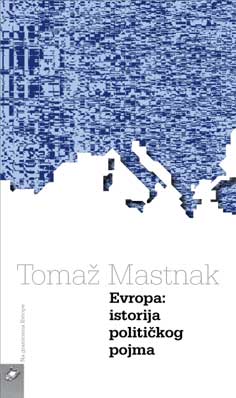
We kindly inform you that, as long as the subject affiliation of our 300.000+ articles is in progress, you might get unsufficient or no results on your third level or second level search. In this case, please broaden your search criteria.


One always searches for some symbolic point from which one can claim that something ended and something else began, even though there are no beginnings and no endings.
More...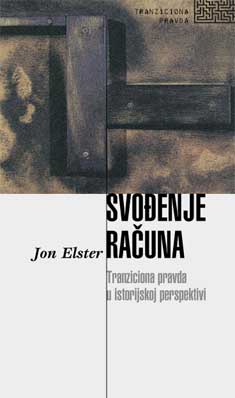
This book offers an analysis of transitional justice - retribution and reparation after a change of political regime - from Athens in the fifth century BC to the present
More...
The Gulag Survivor – Beyond the Soviet System is the first book published in Ex-Yugoslavia to examine at length and in-depth the post-camp experience of Stalins victims and their fate in post-Soviet Russia. Based on extensive interviews, memoirs, official records, The Gulag Survivor describes what survivors experienced when they returned to society, how officials helped or hindered them, and how issues surrounding their existence evolved from the 1950s to the present.
More...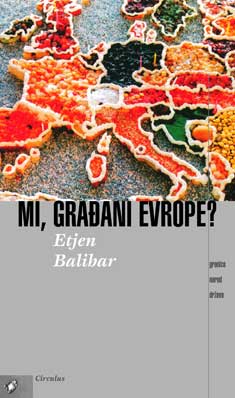
Articles collected in this volume, written mostly in the past five years, attempt to develop themes already articulated in the Les Frontières de la démocratie. The book deals with historical and political borders, as places where citoyenneté and la civilité are being challenged, as loose or firm battle lines where democracy could be tamed or gain new inspiration. It deals with ambiguity of the term »community«, as community of peoples, community of citizens, national community striving to become trans-national on various levels where it is being constructed and sometimes de-constructed. (From Preface)
More...
The first part of this book gives an account of institutional and substantial changes in Europe, its new wars and new challenges, while the second part focuses on a comparative analysis of different transitions. The third part is dedicated to changes in the Croatian society and the transformation the state is going to. Finally, a synthesis of globalization processes is given, as well as projections of futures scenarios for development of transition and globalization processes.
More...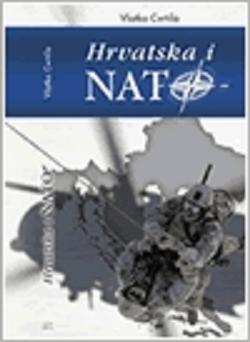
This book delivers a thorough analysis of multiple aspects of NATO involvment in South Eastern Europe and implications for Croatia. It also contains an overview of all positive and negative arguments for Croatia's membership in the NATO
More...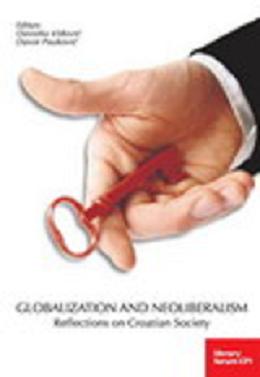
This book is a collection of papers written and presented at the Panel Discussion on Globalization and Neo-liberalism, held on April 19th 2006 in Zagreb. This Panel Discussion was organized by the Political Science Research Centre Forum. It gathered eminent Croatian scientists from different scientific fields of research (sociology, political sciences, economics, history, law, philosophy and others). Multidisciplinary approach ensured a fruitful discussion resulting with this book which aims to enlighten many globalization issues from different aspects and points of view. Understanding the changes in contemporary society connected with processes of globalization and the neo-liberal doctrine and the ways in which they reflect on Croatian society and state requires systematic and multidisciplinary scientific rethinking. In the scope of this comprehension the book intends to provide at least an overview of possible responses to the challenges of the world we live in. Although primarily based on scientific and theoretical ground, papers presented in this book also aim to offer some pragmatic ideas and solutions, which is particulary important for the positioning of Croatian society in the context of transition, European integration and adaptation to global processes. Following the given framework of globalization and neo-liberalism, papers presented in this book examine and question different issues starting with the definition of globalization, neo-liberal globalization and globalism in terms of concepts and contents. Also, putting these phenomena in a historical context offers a basis for understanding of contemporary transformation of society and social structures. Various aspects of global relations have been discussed: the role of major and powerful states, the role of international organizations and transnational corporations, changes in labor conditions, position of small countries, transformation of the welfare state and emersion of new forms of social solidarity, security on global and local level, global environment destruction, antiglobalization responses and others. From different points of view the papers in this book examine almost all important specific implications of the influence globalization and neo-liberalism have on economies, politics, welfare state, regulation, security, environment and social issues, aiming especially at pointing out positive and negative consequences for Croatian society.
More...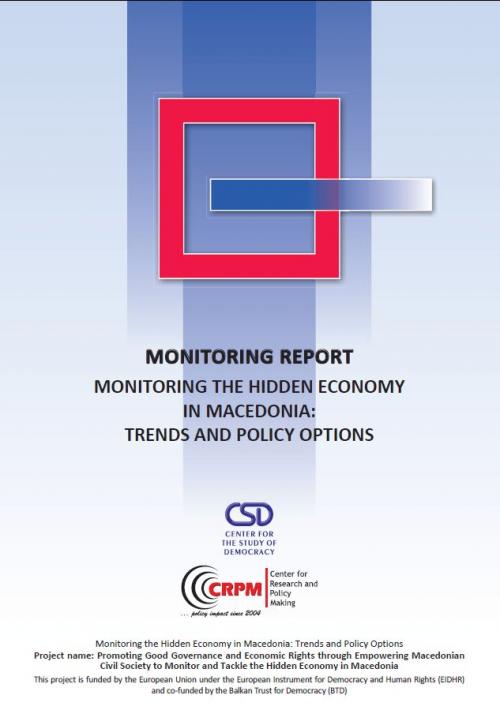
Macedonia features in many discussions as a country with high hidden economy. The European Commission has repeatedly voiced its concerns in its regular country reports about the size and proliferation of hidden economy practices. Hidden employment or undeclared work in Macedonia is of particular concern to the authorities, provided the very high and stubborn levels of official unemployment and low employment levels. However, most studies and research on the matter involve a high level of ambiguity, as they refer to specific narrow outcomes of the hidden economy, usually towards a specific point in time, with dynamics being difficult to trace. The current report, prepared jointly by the Center for the Study of Democracy (CSD) and the Center for Research and Policy Making (CRPM), Macedonia proposes a methodology that would allow the tracing of the dynamics of the hidden economy and its components (e.g. hidden turnover, hidden employment, etc.) over time. This would make possible for the Macedonian government and its European partners to follow the impact and assess the effectiveness of their policies for tackling the hidden economy. Estimates suggest that the hidden economy size in Macedonia ranges from 24% to 47% of its GDP according to different measurement methods. The current report indicates that the percentage of hidden salaries remains the most acute concern, with the employment income of some 40% of Macedonian employees being at least partially undeclared. Moreover, 7% of all Macedonian employees work without a contract, and are not being paid any social security contributions whatsoever. The interviewed business representatives confirmed wide scale violations of the Labour Code. Over half of those respondents claimed that signing contracts with ‘hidden clauses’ (not accounting for the full remuneration paid out) were commonplace in their sector. Moreover, large-scale tax evasion seems to continue to pose a serious problem for the Macedonian economy and social system as the government tries to adjust them in order to be compatible with the principles of the market economy without imposing too extensive erosion of the social fabric and the existing social benefits. Tax avoidance is especially widespread among the poorest members of the society, which makes the underprivileged especially vulnerable as they may find themselves being criminally prosecuted for unpaid taxes or charged with paying large penalties. VAT returns are provided back to companies with significant time lags and represent additional burden for companies which are part of the formal economy. The issuance of cash register receipts also remains an issue, as only less than a half of the respondents claimed that they always received receipts when buying groceries. The situation is similar with the purchase of services.
More...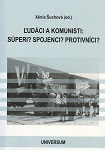
Vznik Československa r. 1918 zastihol Slovensko uprostred procesu premeny z tradičnej na modernú občiansku spoločnosť. Narážali v ňom na seba dve protichodné tendencie: tiahnutie ku konzervativizmu sa odrážalo vo vysokej miere religiozity; modernizačná tendencia sa - okrem iných relevantných znakov - prejavila v prudkej, až agresívnej dynamike politického a verejného života. Obe poznačili aj „zžívanie sa“ domáceho obyvateľstva s vyspelejším a „modernejším“ českým národným elementom v novom spoločnom štáte. V podmienkach hospodárskeho liberalizmu a parlamentnej demokracie, vyznačujúcej sa na jednej strane rozsiahlymi ústavnými právami a slobodami, na druhej strane recipovanými zákonmi rakúsko-uhorskej monarchie, tento prechod nemohol byť priamočiary ani bezbolestný. Prežitá „Veľká vojna“ pustošivo vtrhla do myslí ľudí, narušila, ba prevrátila dovtedajší hodnotový systém a otriasla či aspoň spochybnila predtým nesporné autority: štát a cirkev. Spolu s pretrvávajúcou sociálnou a nacionálnou frustráciou „ľudových“ vrstiev, s ich neschopnosťou pochopiť objektívne príčiny a neochotou vyrovnať sa s pozíciou nerovnoprávneho článku v novom štátnom zväzku, bola aj kríza tradičných hodnôt živnou pôdou pre politický extrémizus - pravý aj ľavý. Zápas s nimi, trvajúci celé medzivojnové obdobie, československú demokraciu oslaboval, až napokon, vyčerpaná a opustená spojencami, podľahla zahraničnej agresii. V polohe dobovej ľudáckej resp. komunistickej rétoriky sú odpovede na otázky položené v titule zborníka pomerne jednoduché a priamočiare; v propagačných brožúrach, politických a verejných prejavoch, straníckej tlači atd. obe hnutia jednoznačne vystupujú ako programoví nepriatelia, nezmieriteľní ideoví protivníci. Na verejných zhromaždeniach organizovaných jednou či druhou stranou sa ich aktivisti navzájom potierali nevyberanými slovnými invektívami, medzi militantnými stúpencami oboch hnutí dochádzalo ku krvavým zrážkam. Naopak, tzv. „štátotvorná“ propaganda v nich rada videla otvorených či skrytých spojencov: pri podkopávaní „československej národnej a štátnej jednoty“, pri torpédovaní základov ústavnej demokracie a spochybňovaní samotnej existencie štátu, pri (domnelej či skutočnej) službe cudzím mocnostiam. Hoci obavy boli namieste, argumentácia vládnych strán bola často až bizarná, no aj kontra-produktívna, pretože skôr zahmlievala ako ozrejmovala nebezpečné spoločné črty pravej a ľavej opozície - symptómy totalitných ašpirácií, rozpoznateľné už od samého začiatku: príchylnosť k autoritatívnym či diktátorským zahraničným vzorom, k ich geopolitickým predstavám a akceptovanie nedemokratického, násilného „rozťatia“ latentných vnútorných problémov. Pri konfrontácii s prameňmi neverejnej povahy sa ukazuje, že skutočnosť bola oveľa zložitejšia a že vz^'ah ľudákov a komunistov bol v priebehu času značne premenlivý. Napriek príležitostným vzájomným „oťukávaniam“ a individuálnym straníckym „prebehlíkom“ tu rozhodne nešlo o spoluprácu v opozícii, hoci podobná, účelovo protivládna rétorika k takejto interpretácii akoby ponúkala. Možno potvrdiť, že od začiatku boli rivalmi: vo volebnej agitácii súperili o priazeň tých istých, t. j. najnižších a nižších stredných sociálnych vrstiev, ťažko zasiahnutých dôsledkami vojny a povojnového rozvratu, krízou tradičných hodnôt, v ďalších rokoch najviac postihnutých dopadom transformácie, modernizácie a racionalizácie a krízového vývoja hospodárstva. Je však zrejmé, že ich vzájomný pomer nemožno spoľahlivo určiť bez prihliadnutia k „tretiemu na ihrisku“. Tým boli tzv. „centralistické“ - občianske aj socialistické - koaličné strany, ktoré formovali a určovali charakter demokratického politického systému. Nefungoval bez chýb a rozhodne poskytoval dostatok dôvodov ako aj príležitostí pre nekompromisnú oponentúru. Spoločným úhlavným protivníkom oboch hnutí, ktoré sa etablovali na jeho pravom resp. ľavom okraji, bol liberalizmus, v ktorom videli základný princíp československej demokracie. Pritom komunistické hnutie v ČSR, a najmä v jej východných častiach, možno prinajmenšom od polovice 20. rokov minulého storočia oprávnene charakterizovať ako ľavý politický extrém, vzhľadom na otvorenú deklaráciu cieľov a prostriedkov: likvidovať pluralitný politický systém, zvrhnúť parlamentnú demokraciu cestou socialistickej revolúcie a nahradiť ju „diktatúrou proletariátu“. Jednoznačná kvalifikácia ľudáckeho autonomistického hnutia ako pravicového extrému však nemá pre medzivojnové obdobie opodstatnenie. Z hľadiska straníckopolitického spektra sa HSĽS deklarovala predovšetkým ako kresťanská, konzervatívna a národná strana a v oficiálnych vyhláseniach rešpektovala, i keď s rastúcimi výhradami, existujúci demokratický systém a režim. Na politickom spektrograme obsadzovala počas celého dvadsaťročia miesto od stredu doprava, i keď od samého začiatku v sebe zahŕňala aj extrémistické zložky, ktoré mali ambíciu aj skrytý potenciál v „priaznivých podmienkach“ ovládnuť celú stranu. Ak politickú stranu charakterizuje okrem programu a organizačnej štruktúry vôľa súperiť o politickú moc, potom táto vôľa nechýbala ani ľudákom, ani komunistom. Kým však ľudová strana počas trvania predmníchovskej republiky čoraz vehementnejšie a agresívnejšie presadzovala svoj nárok na väčší podiel na moci, komunistická strana od samého začiatku cielene smerovala k prevzatiu absolútne celej moci v štáte a k jej podriadeniu potrebám „proletárskej revolúcie“; nech už to aktuálna taktická línia otvorene priznávala alebo, naopak, zastierala. Do novej roviny sa vzťah ľudákov a komunistov dostal po vyhlásení autonómie Slovenska 6. októbra 1938, odkedy HSĽS závratným tempom uskutočňovala demontáž československej demokracie, smerovala k monopolu politickej moci na Slovensku a završovala svoju vnútornú fašizáciu. Predchá-dzajúce spoločné postavenie legálnej parlamentnej opozície sa už prvými opatreniami autoritatívneho Tisovho ľudáckeho režimu zásadne zmenilo na protiklad medzi štáto-stranou a ilegálnym subjektom, vytlačeným mimo politického systému. Narastajúca perzekúcia komunistov po zániku druhej ČSR a počas trvania vojnovej Slovenskej republiky, v ktorej pro-nacistické Tukovo krídlo neustále posilňovalo mocenské pozície a presadzovalo totalitný charakter štátu, je zmapovanou (no aj deformovanou) témou. Neprebádaná je dosiaľ otázka vzájomnej infiltrácie ľudáckeho straníckeho a štátneho aparátu bývalými komunistami a naopak, ilegálnych komunistických a odbojových štruktúr ľudákmi. Takisto novou príležitosťou je skúmanie totalitných praktík a agitačno- propagačných techník „získavania“ národne saturovanej spoločnosti pre proklamované „národné“ ciele ľudákov, v konfrontácii s praktikami a technikami uplatňovanými komunistami po druhej svetovej vojne, v mene „socialistických“ cieľov, na ceste k monopolu moci a po jej uchopení. Na tomto poli doterajší výskum pokročil najviac, vďaka dlhodobej spoločenskej objednávke a záujmu na odhaľovaní zločinov komunizmu. Porovnávaciu rovinu vzájomných vzťahov ľudákov a komunistov tu poskytuje jednak známa činnosti retribučných súdov a bezpečnostných orgánov pri „vyhľadávaní“ a potieraní „zahraničných fašistov a ich domácich pomáhačov“, jednak tiež novo otvorená otázka „dlhých tieňov“ ľudáckej minulosti nad a vo vnútri totalitnej komunistickej strany po februárovom prevrate r.1948. Základ publikácie Ľudáci a komunisti: Súperi? Spojenci? Protivníci? tvoria vystúpenia prednesené na rovnomennej vedeckej konferencii v Banskej Bystrici v dňoch 30.11.-1.12. 2005, ktorú usporiadalo tamojšie pracovisko Historického ústavu Slovenskej akadémie vied v spolupráci s Katedrou histórie Fakulty humanitných vied Univerzity Mateja Bela. Otázku „styčných plôch“ fenoménov ľudáctva a (boľševického) komu¬nizmu slovenská historiografia - pod ideologickou kuratelou vládnucej strany - v minulosti buď celkom obchádzala alebo neprijateľne deformovala. No aj v zmenených spoločensko-politických podmienkach ju dlhší čas nechávala na okraji bádateľského záujmu a prenechávala jej interpretovanie viac či menej zaujatej publicistike. Publikované príspevky, prepracované do podoby vedeckých štúdií a vybavené poznámkovým aparátom, odkazujúcim na zásadné, dosiaľ nepublikované pramene, tak prinášajú množstvo nových poznatkov a otvárajú celkom netradičné pohľady na problematiku. Viacerí autori tu predstavili výsledky svojho najnovšieho výskumu v rámci spoločne riešeného projektu Vedeckej grantovej agentúry SAV č. 2/4183/24 „Radikálny socializmus a komunizmus na Slovensku v rokoch 1918 -1989. Spoločnosť medzi demokraciou a totalitou“. Záverečné slovo prof. Zdeňka Kárníka bilancuje výsledky takmer päťročnej spolupráce českých a slovenských historikov na široko koncipovanom projekte Grantovej agentúry Akadémie vied Českej republiky č. A8063101 „KSČ a radikálni socialismus v Československu 1918 -1989“. Podujatie sa sústredilo na analýzu a komparáciu oboch politických hnutí, ich programov, pôsobenia a ich vzájomných vz^'ahov v meniacom sa spoločensko- politickom kontexte, ako bolo naznačené vyššie: -ako strán operujúcich na pravom resp. ľavom okraji politického spektra predmníchovskej Československej republiky, súčasne využívajúcich a zneuží¬vajúcich systém parlamentnej demokracie; -vo vzájomne obrátených roliach totalitnej štáto-strany a perzekvovaného ilegálneho politického subjektu, aké zaujímali v podmienkach ľudáckeho režimu počas druhej svetovej vojny, resp. v povojnovom období na ceste komunistov k totalitnej moci a po jej ovládnutí vo februári 1948. Autori statí v predstavovanej publikácii netvoria názorovo jednoliaty celok, ani neuplatňujú rovnaké metodologické prístupy. Ponúkajú analytické sondy do jednotlivých oblastí, umožňujúce skôr komparáciu stanovísk oboch strán než syntetizujúci celospoločenský pohľad, čo napokon zodpovedá novosti otvorenej problematiky. Pokiaľ niektoré čiastkové závery pôsobia provokujúco - potom to tak má byť: zmyslom a cieľom publikácie je pozvať širokú historickú obec k argumentovanej diskusii o nadhodených otázkach.
More...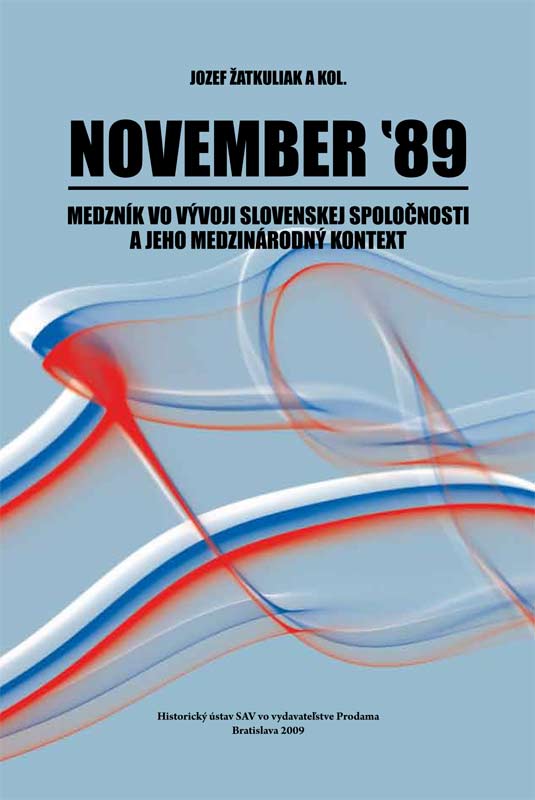
November 17th 1989 is one of the most important milestones in the Slovak and Czech history in the 20th century. It initiated deep social changes and it led to global changes of the political system, and in consequence it opened the way for a Slovak and Czech society’s way towards democracy – political and economic plurality, civic and political freedom. It was put an end to the monopole of Communist Party of Czechoslovakia, that continuously held the political power in country since the coup d’état in February 1948 and forced the Slovak and Czech society to accept its will through directives, and often frequently, by using the force. Both societies as well as national minorities living in Czechoslovakia expected from the November ’89 not only some partial corrections of socialism, what was the case more than twenty years before during the crucial events of the Czechoslovak Spring in 1968. In November 1989, the inhabitants of Czechoslovakia wanted something more – their allegations were going behind the frames of the existing socio-political system. They had enough experience with the practices and the policy of the communist regime, more than years before they were able to compare the existing political situation and the economic conditions with the situation in the democratic Europe in order to formulate more concrete expectations concerning the future. The distance between the people and the policy of the communist regime was more and more evident, as they confronted their own conditions with the situation in the democratic countries of Western Europe. On the other hand, there was a part of society that was relatively satisfied by some social conveniences offered by the socialist system, although these conveniences were often insufficient and strictly limited by the stagnating and unproductive economic system. The leaders of communist party were aware of the fact that their normalization-policy and incapability to introduce essential corrections of the political mechanism felt into the contradiction with changing inner political and social atmosphere in Czechoslovakia. It was in the first half of 1980’s, when it came to an outstanding differentiation of both Slovak and Czech society. A new generation grew up, which by its background determined by education and ideas completely exasperated the existing social-political and cultural-economic reality and was far beyond the normalization-policy of the communist regime. In its distance or even antipathy to the political regime, this new “wave” found common interest with the disappointed generation of 1968. Its another “ally” was a respectable part of Slovak and Czech intelligence in its effort to accentuate the adherence to human rights and civil liberties and the observance of religious freedom, cultural freedom, the freedom of education and scientific research. Main part of this publication, which contains also an introduction and selected bibliography, is focused on chronological overview of historical events concerning in particular Slovakia, although in a whole-Czechoslovak context. It is divided in two main parts. The first one starts with the silent manifestation of March 25, 1988, the so-called “candlelight demonstration”, that become one of the most significant manifestations of resistance against the communist regime. The end of this part is marked by November 16, 1989, that means by the eve of the events that had enormous importance for the whole development of Slovak and Czech society. The second part begins with November 17, 1989, and goes on till parliamentary elections that took place on June 8 – 9, 1990, e.g. elections of constitutional functionaries and the creation of federal and national governments in both parts of republic. The authors of both chronologically divided parts were taking into account the social-political, constitutional, economical, cultural, social and other context. Also reflected are international affairs of that time, first of all the social movement in the neighbor states Soviet Union, German Democratic Republic, Poland, Hungary and other states. At the same time the authors consider corrections in bilateral relations between the USSR and the USA as well as the Soviet Perestroika, which brought new impetus to the Slovak and Czech society and which in many aspects gave them an “eye opening” look. The impact of the Helsinkiprocess aimed at the respect for human rights and fundamental freedoms and the cooperation between the East and the West was similar. At the end of 1980’s, the Perestroika and the Helsinki-process had crucial influence on the inner political and social development in Czechoslovakia. The bipolar world was slowly falling into pieces and the iron curtain between the East and the West was about to became history. Chronological records listed in both parts of this publication indicate, that the main protagonists of social/political development right after November ’89 – the VPN (Public against Violence) in Slovakia and the OF (Citizens Forum) in the Czech lands – laid down the condition of radical social transformation including a new order, pluralistic political system and parliamentary democracy and the reconstruction of local selfgovernment, as well as the consistent modification of state-political relations between the Slovak and Czech nation and the beginning of a economic and social reform. Further, they demanded freedom for culture, educational system and science and the revaluation of the foreign policy of Czecho-Slovak federation. Until the parliamentary elections in June 1990, the Slovak and Czech society overrun a fundamental transformation process in all spheres. Compared to similar development taking place in the neighbor states, this transformation process had some specific elements. Nevertheless, besides all specifics, all Central European post-communist states were about to participate in the process of European integration.
More...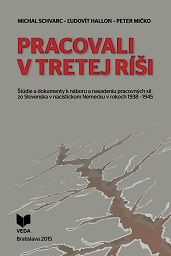
Sie arbeiteten im Dritten Reich. Studien und Dokumente zur Anwerbung und zum Einsatz slowakischer Arbeitskräfte im Deutschen Reich 1938 – 1945 Der Slowakische Staat, seit dem 21. Juli 1939 offiziell Slowakische Republik (SR) ist sowohl in der Fach- als auch in der Laienöffentlichkeit immer wieder ein lebhaft erörtertes Thema. Ungeachtet dessen bleiben noch viele Fragen unbeantwortet, einige Problemkomplexe unberührt oder nur teilweise erforscht. Zu jenen Fragen gehört auch die Anwerbung slowakischer Arbeitskräfte nach Deutschland in den Jahren 1939 – 1945. Wenngleich es sich um ein bedeutsames Kapitel der kurzen Geschichte des Slowakischen Staates handelt, wurde es von der slowakischen Historiografie eine lange Zeit kaum reflektiert. Eine Ausnahme stellen nur einzelne Arbeiten tschechoslowakischer/slowakischer Provenienz dar. Diese behandeln jedoch nicht alle Ebenen des untersuchten Problems. Darüber hinaus orientieren sie sich fast ausschließlich an dem inländischen Schriftgut. Veranlasst durch diese Sachlage entschieden wir uns, die Anwerbung slowakischer Arbeiter nach NS-Deutschland in Form der kommentierten Quellen näher zu beleuchten, wobei den Kern der vorgelegten Edition Dokumente deutschen Ursprungs bilden, die bis jetzt unbekannt waren und noch nicht publiziert wurden. Wir haben dadurch neue Erkenntnisse zu den Zwangsformen und Methoden der Anwerbung durch nationalsozialistische Militär- und Polizeidienststellen nach Ausbruch des Slowakischen Nationalaufstandes bzw. nach dem Übergehen der Front auf das slowakische Staatsgebiet im Winter 1944/1945 sowie zur Lösung der Frage der unbezahlten Löhne in der Nachkriegszeit zutage gefördert. Wir betrachten das Phänomen zugleich als eine Art der ökonomischen Migration, dessen Katalysator eine hohe Arbeitslosigkeit in den Jahren 1939/1940 und unvergleichbar bessere Lohnverhältnisse im Reich waren. Dies erklärt die anfängliche große Nachfrage der produktiven Bevölkerung, eine Arbeitsstelle in Deutschland zu bekommen. Das Ziel des vorgelegten Werkes ist, den Stand der Kenntnisse dieser zweifellos interessanten Problematik zu erweitern. Die hier publizierten Dokumente bringen nicht nur die Auskünfte über den Anwerbungsverlauf, die Arbeits- und Lebensbedingungen slowakischer Arbeiter im Deutschen Reich, die Zahlenangeben der angeworbenen Staatsangehörigen der SR, sondern sie helfen außerdem, das Bild über die einzelnen Aspekte der politisch- wirtschaftlichen Beziehungen zwischen dem Slowakischen Staat und der deutschen „Schutzmacht“ abzurunden. Auf alle mit diesem Thema zusammenhängenden Fragen kann die Edition allerdings nicht entsprechende Antworten geben. Die Gründe dafür sind vielschichtig: Umfang des Forschungsgegenstandes, Zerstreuung des Archivguts, dessen Unvollständigkeit sowie eine ständige finanzielle Vernachlässigung der slowakischen Wissenschaft. Auf der anderen Seite soll diese Edition als eine Basis für weitere Nachforschung der Problematik dienen. Die Beziehungen zwischen der Slowakischen Republik und derer „Schutzmacht“ – dem Deutschen Reich – gestalten sich 1939 – 1945 vor allem auf zwei Ebenen: auf politischer und wirtschaftlicher. Die Anwerbung slowakischer Arbeitskräfte nach Deutschland während des Zweiten Weltkrieges stellt einen Schnittpunkt beider Ebenen dar. Es handelte sich dabei nicht um rein ökonomische Angelegenheiten und die Werbung slowakischer Staatsbürger war auch stark politisch gefärbt, insbesondere als Ferdinand Ďurčanský 1939 – 1940 die Posten des Außen- und Innenministers innehatte. Ihre politische Implikationen verlor sie späterhin auch nicht, als die slowakische Seite, insbesondere nach Übergehen Italiens ins Lager der Alliierten im Herbst 1943 sowie den verheerenden Niederlagen der Wehrmacht an der Ostfront im Frühjahr und Sommer 1944 versuchte, ihre Vertragsverpflichtungen gegenüber dem „Schutzherrn“ dilatorisch zu behandeln. Man muss sagen, dass es nur bei den Versuchen blieb und die Deutschen besaßen noch immer viele wirksame Schalthebel, um zu erreichen, was ursprünglich vereinbart wurde. Nach dem Ausbruch des Aufstandes wurde die Anwerbung bzw. die zwangsläufige Rekrutierung der Arbeitskräfte zum puren Politikum. Den höchsten Regimevertretern sowie den Staatsbehörden ist trotz Interventionen, die nur in vereinzelten Fällen zum Erfolg führten, nichts übriggeblieben, als ohnmächtig ansehen zu müssen, wie die nationalsozialistischen Militär- und Polizeidienststellen eigenmächtig die arbeitsfähige Bevölkerung manipulierten und ganze Gruppen von Bürgern außerhalb des Staatsgebiets abtransportierten. Die Slowakische Republik war weder einziger, noch ausschließlicher Lieferant billiger Arbeitskräfte in das NS-Deutschland. Die zuständigen Behörden des Dritten Reiches mussten sich mit diesem Problem schon seit 1936 auseinandersetzten, als sich der Mangel an Arbeitskräften praktisch in allen Wirtschaftszweigen, insbesondere in Landwirtschaft und Schwerindustrie, zeigte. Den Ausgang aus der unerfreulichen Lage bot die Rückkehr zu einem schon bewährten Instrument: zu den bilateralen Staatsverträgen, die bis zum Beginn der Wirtschaftskrise Anfang der 1930-er Jahre auch selbst von Deutschland abgeschlossen wurden. Wiederaufgenommene Anwerbung in der Tschechoslowakei und in Polen (1935, 1937) sowie die Vereinbarungen mit Italien (1937), mit der Tschecho-Slowakei, mit Bulgarien und Jugoslawien (1939) konnten die aufgerissenen Lücken auf dem Arbeitsmarkt nicht schließen. Eine Wende in dieser Hinsicht trat nach der Besetzung der „Rest-Tschechei“ im März 1939 bzw. nach dem Beginn des Zweiten Weltkrieges ein. Das Phänomen der Zwangsarbeit wurde einer der symptomatischen Züge der deutschen Okkupationspolitik. Sie wurde durch eine gewaltsame Verschleppung aus der Heimat, Deportation ins Deutsche Reich und unfreiwilligen Arbeitseinsatz unter schlechten, sogar menschenunwürdigen Arbeits- und Lebensbedingungen (Polen, sog. „Ostarbeiter“ und seit Herbst 1943 italienische Militärinternierte) charakterisiert. Von den insgesamt 13,5 Millionen der angeworbenen, inhaftierten und verschleppten ausländischen Zivilarbeiter, Kriegsgefangenen sowie KZ-Häftlingen kann 80-90 % als zwangsläufig eingesetzt betrachtet werden. Obwohl das NS-Deutschland einen faktisch uneingeschränkten Zugang zum Arbeitskräftereservoir der besetzten Gebiete hatte (zuständige Behörden konnten jedoch die vakant gewordenen Arbeitsplätze nicht füllen und seit Ende 1941 kämpfte die Verwaltung mit einem brennenden Defizit an Arbeitskräfte), nutze es weiter die Ressourcen seiner Verbündeten und Satelliten. Je stärker das Land politisch und wirtschaftlich mit dem Reich verbunden wurde, desto leichter war es für Berlin, von seinen Vertretern die Zugeständnisse im Sinne der eigenen Interesse zu erzwingen. Als ein exemplarisches Beispiel dafür dienen die Slowakei und Kroatien – die Staaten, die als Nebenprodukte der expansiven deutschen Außenpolitik entstanden sind. Der Slowakischen Republik, wenn wir die Zahl der Bevölkerung insgesamt in Erwägung ziehen, gehörte in der Lieferung von Arbeitskräften nach Deutschland unter dessen Verbündeten aus Südosteuropa (Ungarn, Rumänien, Bulgarien, Kroatien) bis in die Hälfte 1944 der erste Rang. Dies wurde nicht nur durch den oben erwähnten diplomatischen Druck, sondern auch durch andere Umstände hervorgerufen: durch die anfänglich hohe Arbeitslosigkeit, unvergleichbar bessere Lohnverhältnisse, Bevorzugung der deutschen Minderheit bei der Anwerbungsaktionen und nicht zuletzt durch die Bereitschaft des Regimes, mit der „Schutzmacht“ zu kollaborieren. Man kann auch die Tendenzen des Regimes nicht außer Acht lassen, die eigene Bevölkerung dazu zu zwingen, sich „freiwillig“ anwerben zu lassen. Jene Neigungen wurden erst später spürbar, als unter dem Eindruck des Luftkrieges über Deutschland, der eine rapide Verschärfung der Arbeitsund Lebensbedingungen zur Folge hatte und der Großteil der Arbeiter die Rückkehr nach Deutschland ablehnte. Die angeführten Aspekte machen aus der Anwerbung slowakischer Arbeitskräfte ein, historisch gesehen, einziehendes Thema, wenn auch die vorgelegte Quellenedition nicht alle angeschnittenen Fragen beantworten kann. Im Gegensatz zur slowakischen Geschichtsschreibung ist die Problematik der Heranziehung ausländischer Arbeitskräfte (in erster Reihe die Problematik der Zwangsarbeit) in das NSDeutschland international, insbesondere in der deutschen Geschichtsschreibung viel stärker reflektiert. Das Ergebnis dieses Interesses ist eine große Anzahl von Monographien und Sammelbänden, die sich mit (gewaltsamer) Einschaltung der Ausländer in den Arbeitsprozess, nicht nur aus einer Gesamtperspektive, sondern auch in den einzelnen, vom Reich kontrollierten Regionen oder Betrieben befassen. Die Slowakei taucht in diesen Werken nur selten, überwiegend mit faktografischen Ungenauigkeiten auf. Dennoch ist es notwendig, sich mit den neuen methodologischen Trends vertraut zu machen, sich von ihnen inspirieren zu lassen und versuchen, die eingewurzelten Stereotype in der westeuropäischen Historiographie durch die Projizierung des Themas in einem breiteren Zusammenhang, womöglich auf internationales Forum, abzuschaffen. Die von uns vorgelegte Edition kann dieses Versäumnis nicht nachholen, sondern nur zum Teil kompensieren. Einer der Gründe, warum die Anwerbung slowakischer Arbeitskräfte nach Deutschland in der ausländischen Fachliteratur kaum beachtet wird, ist das Fehlen von bedeutsamen Angaben in den primären Quellen der Zentralstellen, die für den »Arbeitseinsatz« ausschlaggebend zuständig waren (Reichsarbeitsministerium, der Generalbevollmächtigte für den Arbeitseinsatz – GBA, Deutsche Arbeitsfront – DAF, Reichssicherheitshauptamt – RSHA). Die zahlenmäßigen Daten sind zwar in den mehrmals im Jahr erscheinenden statistischen Zusammenstellungen Arbeitseinsatz für das Großdeutsche Reich vorhanden, auf die Umstände der Anwerbung von Slowaken stößt man in den Akten der oben erwähnten Behörden nur selten auf. Außer der bilateralen Vereinbarungen aus den Jahren 1939, 1941, 1943 und der Abmachung über die Gastmitgliedschaft slowakischer Staatsangehöriger in der DAF, tritt die Slowakei in Dokumenten größter Relevanz nicht in Erscheinung. Das RSHA hat z. B. keine speziellen Richtlinien über die Behandlung slowakischer Arbeitskräfte ausgearbeitet. Fritz Sauckel als Generalbevollmächtigter für den Arbeitseinsatz (die Dienststelle begann ihre Tätigkeit im April 1942) hat in den Besprechungen mit den zuständigen Stellen dieses Problem nicht explizit behandelt und betrachtete es als einen Bestandteil des umfassenden Programms der Ausländeranwerbung. Die Slowakei fiel meist unter die Rubrik „sonstige europäische Länder“, man sprach über sie nur allgemein im Zusammenhang mit verstärkter „Mobilisierung von Arbeitskräften in den besetzten Gebieten und in den befreundeten Staaten“ und mit der Rekrutierung „in den Ländern, in denen keine Kampfhandlungen stattfinden… (Dänemark, Protektorat, Ungarn, Slowakei)“. Interne Korrespondenz des Auswärtigen Amtes und das Schriftgut der Dienststelle des Beauftragten des Reichsarbeitsministers, seit 1942 des GBA in Bratislava wurden kaum berücksichtigt. Gerade die nicht komplexe Bearbeitung der Formen der Anwerbung in den verbündeten Ländern Südosteuropas seitens der westeuropäischen Geschichtsschreibung kann man als einen weiteren Grund der Nichtwahrnehmung der Slowakei in diesem Zusammenhang nennen. Dies gilt sowohl für die westeuropäische Geschichtsschreibung als auch für die Historiographie in der betreffenden Region. Der dritte, nicht weniger wichtige Grund, ist das geringe Interesse der slowakischen Historiographie an der Problematik. Obwohl die Anwerbung einen nicht unerheblichen Teil der produktiven Population der damaligen Slowakischen Republik betraf, sind, wie bereits erwähnt , bislang nur zwei relevante Werke geschrieben worden, die im Ausland keinen Niederschlag gefunden haben. Darüber hinaus wurde das Thema von keinem einzigen slowakischen Historiker auf der internationalen Bühne bekannt gemacht, und so konnte es kaum ins Bewusstsein ausländischer Wissenschaftler gelingen. Die vorgelegte Quellenedition enthält 152 Dokumente zur Problematik der Anwerbung slowakischer Arbeitskräfte nach Deutschland zwischen den Jahren 1939 und 1945. Weitere, deren Relevanz wir nicht für so überragend hielten bzw. die mit den Grunddokumenten direkt zusammenhängen, wurden im Rahmen des Fußnotenapparats komplett oder auszugsweise publiziert. Alle Dokumente sind amtlicher Provenienz. Ein Großteil von ihnen ist als Schriftgut der deutschen zentralen Staats- und Parteibehörden sowie der in der Slowakei tätigen Dienststellen überliefert worden. Es handelt sich vor allem um die Berichte des Beauftragten des Reichsarbeitsministeriums, seit Frühjahr 1942 des Generalbevollmächtigten für den Arbeitseinsatz in Bratislava, ergänzt durch interne Korrespondenz des Auswärtigen Amtes (Berichte und Telegramme der deutschen Gesandtschaft in Bratislava und der Berliner Zentrale in Wilhelmstraße 74-76). Einige Dokumente stammen vom RSHA, von der Dienststelle des Sonderbeauftragten des Reichsführers-SS und Chefs der deutschen Polizei bei der deutschen diplomatischen Mission in der Slowakei, vom SD-Leitabschnitt in Wien, von dem Berater für soziale Fragen bei slowakischer Regierung, Albert Smagon, von der Einsatzgruppe H der Sicherheitspolizei und des SD und vom Befehlshaber der Sicherheitspolizei und des SD in der Slowakei. Den zweiten Teil bilden die Akten slowakischer Behörden, in erster Reihe des Innenministeriums – Zentralarbeitsamt, des Außenministeriums (Zentrale, Berliner Gesandtschaft und Wiener Generalkonsulat), des Regierungspräsidiums, des Generalsekretariates der Slowakischen Volkspartei Hlinkas u. a. Die dritte, am wenigsten vertretene Gruppe der Quellen stellen die Dokumente tschecho-slowakischer/ tschechoslowakischer Provenienz der Jahre 1938 – 1939 bzw. der Nachkriegszeit dar. Vom thematischen Blickpunkt aus gesehen, beschäftigt sich der Großteil der publizierten Quellen mit dem Verlauf der Rekrutierung slowakischer Arbeitskräfte nach Deutschland. Von weiteren Problembereichen können Lohntransfer, Arbeits- und Lebensbedingungen angeworbener Arbeiter genannt werden. Als eine besondere Gruppe sind die Dokumente, welche die Zwangsanwerbung nach dem Ausbruch des Slowakischen Nationalaufstandes bzw. nach der Erklärung eines Teils der Slowakei zum Operationsgebiet der Wehrmacht beleuchten, anzugeben. Dieses Thema wurde bisher von der slowakischen Historiographie noch nicht thematisiert. Dasselbe gilt auch für die Kompensierung für die nicht bezahlten Löhne, welche das Nachkriegsregime der gesteuerten Demokratie sowie nach dem Februarumsturz 1948 die Kommunisten lösen mussten. Wir haben in die Edition auch einige Dokumente allgemeiner Natur eingereiht. Sie weisen nicht nur auf eine differenzierte Behandlung der »fremdvölkischen« Arbeitskräfte durch polizeiliche Behörden, sondern auf das Bemühen des NS-Regimes, die Anwerbung der Arbeiter aus den Ländern Südosteuropas im gemeinsamen „Kampf gegen Bolschewismus“ propagandistisch auszuwerten, hin. Manche partielle Probleme, wie beispielsweise die Frage des Arbeitseinsatzes internierter Angehöriger der sog. ostslowakischen Armee, die Frage der Gerichtsbarkeit gegenüber slowakischen Staatsbürgern, Arbeits- und Lebensbedingungen an einzelnen Arbeitsplätzen, die Haltung lokaler staatspolizeilichen Dienststellen gegenüber den Slowaken usw. konnten in die Edition nicht einbezogen werden. Die zugeteilten Geldmittel im Rahmen des Projektes haben einfach nicht dazu gereicht, um überhaupt zu den hier angeschnittenen Fragen Forschung einzuleiten. Die Herausgeber haben bei der Untersuchung zum Thema das Augenmerk auf zentrale Archive in der Bundesrepublik Deutschland gerichtet. Die Recherchen im Politischen Archiv des Auswärtigen Amtes in Berlin konzentrierten sich in erster Reihe auf das überlieferte Schriftgut der Gesandtschaft Preßburg. Zwei Pakete (75 und 208) dieses Archivbestandes umfassen Akten zur Anwerbung slowakischer Arbeitskräfte nach Deutschland. Es handelt sich um die bereits erwähnten Berichte des Beauftragten des Reichsarbeitsministeriums bzw. des GBA sowie der Gesandtschaft. Es ist ein unvollständiges Material (Kopien und Abschriften dieser Dienststelle), welches trotz dieser Tatsache ein tragfähiges Gerüst der Edition bildet. Darüber hinaus wurden weitere Bestände gesichtet: Konsulat Preschau, Handelspolitische Abteilung – Handakten Wiehl, Waldern, Kulturpolitische Abteilung, Referat Partei, Referat Inland II geheim und Rechtsabteilung. Dort wurden keine slowakeibezogene Schriftstücke gefunden. Wir haben auch einige allgemeinen Dokumente zum Thema Arbeitseinsatz der Bevölkerung aus Südosteuropa im Reich in die Edition eingefügt. Im Bundesarchiv in Berlin zeigten sich R 70 Slowakei – Polizeidienststellen in der Slowakei und die Mikrofilmesammlung SS Verschiedener Provenienz als relevante Bestände. Dort sind Berichte verschiedener SD-Dienststellen über die Lage slowakischer Arbeiter in Deutschland, über die Entstehung ausländischer Hlinka-Garde sowie ein Material zur zwangsläufigen Rekrutierung slowakischer Bevölkerung im Herbst 1944 und im Winter 1944/1945 überliefert worden. Nützliche Hinweise zum Thema geben auch die Bestände R 3901 – Reichsarbeitsministerium, R 16 – Reichsnährstand und R 3601 – Reichsministerium für Ernährung und Landwirtschaft. Fehlende Schriftstücke der Dienststelle des Beauftragten des Ministeriums, später des GBA haben wir in der Registratur jedoch nicht gefunden. Als weitere Bestände, aus welchen wir Dokumente schöpften, sind anzuführen: NS 18 – Reichspropagandaleiter der NSDAP, NS 19 – Persönlicher Stab Reichsführer-SS, R 2 – Reichsfinanzministerium, R 59 – Volksdeutsche Mittelstelle, R 901 – Auswärtiges Amt, Handelspolitische Abteilung 1936 – 1945 und R 5101 – Reichsministerium für die kirchlichen Angelegenheiten. Gesichtet wurden sowohl R 3 – Reichsministerium für Rüstung und Kriegsproduktion, R 43 – Reichskanzlei »Neue Reichskanzlei« als auch R 3101 – Reichswirtschaftsministerium. Recherchearbeit in diesen Beständen hat kein nennenswertes Ergebnis gebracht. Infolgedessen haben wir noch einige ergänzende Recherchen im Institut für Zeitgeschichte in München sowie in Wien durchgeführt. Für Forschungsarbeiten in den Landes-, Staats- und Betriebsarchiven in Deutschland sowie in Österreich hatten wir nicht genug Geldmittel zur Verfügung. Slowakische Archive bieten für „unser“ Thema verhältnismäßig große Anzahl des Schriftguts an. Im Vergleich zu den Quellen deutscher Provenienz müssen wir jedoch feststellen, dass es sich vorwiegend um die Dokumente geringer Relevanz handelt. Nur in seltenen Fällen stießen wir auf sich periodisch wiederholende analytische Berichte, tiefgehende Expertisen oder Denkschriften. Darüber hinaus sind die Akten lückenhaft und verstreut in mehreren Archiven sowie Beständen. Die ausführlichste Forschung haben wir selbstverständlich im Slowakischen Nationalarchiv in Bratislava absolviert. Als die wichtigsten Bestände können wir in dieser Hinsicht Úrad predsedníctva vlády (Amt des Regierungspräsidiums) 1938–1945, Ministerstvo zahraničných vecí (Miniterium des Äußern) 1939–1945, Ministerstvo vnútra (Ministerium des Innern) 1938–1945, Ministerstvo financií (Ministerium der Finanzen) 1939-1945 bezeichnen. Dort ist das bedeutendste Material slowakischer Provenienz konzentriert. Die Recherchen beschränkten sich nicht nur auf diese Bestände. Gesammelte Dokumente haben wir durch die Forschung in Registraturen von Ministerstvo hospodárstva (Wirtschaftsministerium) 1938–1945, Povereníctvo financií (Beauftragter für das Finanzwesen)1945–1960, Úrad obžalobcu pri Národnom súde (Amt des Staatsanwaltes beim Nationalgericht) 1945– 1948, Hlinkova garda (604), Ministerstvo pravosúdia (Justizministerium) 1938–1945, Archív kancelárie prezidenta republiky Praha (Archiv der Kanzlei des Präsidenten der Republik Prag) und a Kancelária prezidenta republiky (Kanzlei des Präsidenten der Republik) 1939–1945 ergänzt. Die Akten aus diesen Archivbeständen bilden die Basis des slowakischen Teils der Edition. Die Recherchen im Archiv der Nationalbank der Slowakei, im Nationalarchiv der Tschechischen Republik, im Archiv des Außenministeriums der Tschechischen Republik sowie im Staatsarchiv in Banská Bystrica hatten ausschließlich einen aufklärenden Charakter. Einen Bruchteil der durchgesehenen Materie haben wir in der Edition entweder als Dokumente, oder als Hilfsmaterial in den Fußnoten verwendet. Die Nachforschung in den Registraturen von einzelnen Arbeitsämtern in Staatsarchiven sowie eine eventuelle Umfrage unter den noch lebenden Zeitzeugen wurden wegen Mangels an finanziellen Mittel nicht durchgeführt. Die Publikation stellt ein Endergebnis des dreijährigen Projektes (2009 – 2012) VEGA der Slowakischen Akademie der Wissenschaften (SAW) und des Schulministeriums der Slowakischen Republik Nr. 2/0090/10 Wirtschaftliche Migration in der Slowakei in den Jahren 1939 – 1945, an welchem die wissenschaftlichen Mitarbeiter des Historischen Instituts der SAW und des Lehrstuhls für Geschichte der Fakultät der Geisteswissenschaften in Banská Bystrica zusammenarbeiteten.
More...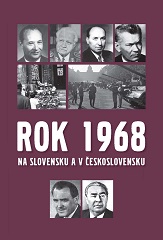
Rok 1968 predstavoval v slovenských a v československých dejinách jedinečný pokus nenásilným spôsobom reformovať totalitný spôsob vládnutia uplatňovaný v rámci vtedajšej socialistickej spoločnosti. Pražská – a či presnejšie československá alebo česká a slovenská – jar bola súčasťou politickej konfrontácie, ku ktorej v rozličnej forme opakovane prichádzalo v štátoch sovietskeho bloku takmer od jeho vzniku. Československá jar najpregnantnejšie vyjadrila nesúhlas a odpor verejnosti proti direktívnym metódam vládnutia s ich negatívnymi dôsledkami na život slovenskej a českej spoločnosti, na ich modernizáciu, kultúrno-spoločenské napredovanie i morálny status. Je symptomatické, že k pokusom zmeniť politický systém za existencie sovietskeho bloku prišlo v Poľsku, v Maďarsku, v Nemeckej demokratickej republike a v Československu, ale nič podobné sa neobjavilo v ďalších krajinách socialistického tábora. To malo okrem dobových politických, ekonomických, spoločenských a ďalších príčin špecifický historický dôvod v tom, že menované národy a štáty ležali v stredoeurópskom priestore a v minulosti sa v mnohých smeroch navzájom ovplyvňovali. V Československu bol reformný proces aj prejavom toho, že veľká časť slovenskej i českej verejnosti sa zbavila ilúzií, ktorým podľahla po februári 1948 a ktoré spočiatku chápala azda ako snahu o nastolenie sociálne spravodlivých pomerov. Bolo však charakteristické, že spoločnosť si vytýčila za cieľ reformovať existujúci systém, no narážala na vážne medzinárodné a vnútropolitické prekážky. Snaha o radikálnu zmenu spoločenského života ohrozovala nielen totalitný systém vo vtedajšom Československu, ale bola hrozbou aj pre samotnú existenciu socialistického tábora, t. j. fakticky pre veľmocenské postavenie Sovietskeho zväzu v Európe a vo svete. Pokus Čechov a Slovákov o demokratizáciu spoločnosti a odstránenie totalitného režimu mal svoje korene nielen v nedávnej minulosti oboch národov, ale koreš- pondoval aj s dobovými demokratickými hnutiami vo svete a vyvieral zo snahy posunúť vývin českej a slovenskej spoločnosti na úroveň demokratickej časti sveta. Preto bol tento proces mnohorozmerný, mal svoju osobitú politickú tvár, svoje vlastné ekonomické koncepty a plány, svoje pohľady na verejný život a miestnu správu, kultúrne a národné požiadavky vrátane tých, ktoré sa týkali ľudských práv, náboženskej slobody a rehabilitácie nespravodlivo odsúdených. Vzhľadom na to, že v slovenskom prostredí už od vzniku spoločného štátu Čechov a Slovákov roku 1918 mimoriadne rezonovala často pertraktovaná požiadavka riešenia „slovenskej otázky“, jej nastolenie muselo byť organickou súčasťou reformného procesu. K demokratizácii spoločnosti totiž nemohlo prísť bez zásadnej úpravy postavenia Slovenska v štáte, ale aj česko-slovenských vzťahov a s tým súvisiacich problémov. Rozmach národného povedomia a nárast národ ného sebavedomia, ktorý sa v živote slovenskej spoločnosti razantne a jednoznačne prejavil po roku 1918, sa musel materializovať vo všetkých sférach života a riadenia spoločnosti, musel sa stať organickou súčasťou prebiehajúcich spoločenských zmien. Je príznačné, že z mnohých reforiem, ktoré sa pripravovali a uskutočnili roku 1968, pretrvala – aj keď v značne deformovanej podobe – práve zmena republiky na federatívny štátny útvar. Predkladaná publikácia je jedným z výstupov riešenia projektu APVV Chronológia dejín Slovenska a Slovákov. Vznikla v rámci práce na aktuálnych výskumných projektoch vrátane významu „osmičiek“ v slovenských národných dejinách, resp. v dejinách bývalej Československej republiky a jej ambíciou je poskytnúť čitateľom ucelenú sumu faktov o roku 1968. Autori publikácie zvolili pri jej príprave chronologický prístup, aby takýmto spôsobom upozornili v primeranom rozsahu na všetky základné stránky udalostí roku 1968 – na ich vnútropolitickú československú (českú a slovenskú) dimenziu vrátane štátoprávnej prestavby republiky, ale aj na medzinárodné súvislosti, reakcie veľmocí, jednotlivých štátov i verejnej mienky vo svete na konkrétne udalosti roku 1968 v Československu, resp. na československý reformný proces ako taký. Z toho je zrejmé, že primárnym cieľom autorov bolo ukázať vývoj na Slovensku v prirodzenej komparácii s dianím v celej Československej socialistickej republike a dianie v Československu v korelácii s jeho odrazom na medzinárodnej scéne, predovšetkým v krajinách vtedajšej Varšavskej zmluvy ovládanej Moskvou. To si vyžadovalo venovať zvýšenú pozornosť aj medzinárodnopolitickým súvislostiam augusta 1968, lebo práve vonkajšie faktory aj vtedy osudovo zasiahli do dejín Československa. Autori veria, že čitateľ nájde v práci informácie o všetkých relevantných udalostiach „československého“ roku 1968 i o faktoroch, ktoré spolurozhodovali o jeho osude. Chronológia udalostí spolu s úvodnou štúdiou, ktorá hovorí o tom, čo predchá- dzalo roku 1968 v Československu, umožňuje vytvoriť si v nadväznosti na iné historické práce plnší obraz o nedávnej minulosti slovenského a českého národa, o roku, ktorý akoby potvrdzoval, že tradičné „osmičky“ mali v našej spoločnej minulosti nielen nádejeplný, ale neraz i tragický rozmer.
More...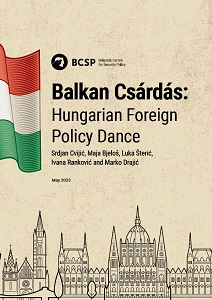

This book comprises essays on political transition in Serbia, written in the 1997 – 2006 period. Twenty-four works are devoted to sociological and politicological-legal aspects of the great changes in the now already considerably differentiated world of post-communism. Particular attention is focused on the problems of an overdue and deformed transition in Serbia, meaning that in the centre of the analysis there are complex interactions of culture and institutional structure in a society that has not yet emerged from the grip of a deep crisis of the change and has not resolved still numerous dilemmas in the confrontation with the many “shocks of the reality”. This relationship may actually be taken as the “red thread” of the topically various reflections of political controversies and theoretic-ideological dilemmas concerning the aims, contents, pace and means of building a modern state and nation, as well as of consolidation of democracy in a heterogeneous (multicultural, pluralist) social setting of Vojvodina and Serbia as a whole. All this has, therefore, caused the essays, the majority of which have so far been published in thematic anthologies and periodicals, to be grouped in this book in five topical wholes.
More...
Srbija je u proteklih nekoliko godina prošla kroz duboke političke, socijalne, kulturne i institucionalne promene. Zakonodavne promene u oblasti lokalne samouprave predstavljaju osnov za demokratizaciju političkih struktura koje su u ulozi donosilaca odluka. Pored toga, započet proces decentralizacije državnih institucija i službi javne uprave pomogao je da se poveća njihova efikasnost, transparentnost i odgovornost. Posebno je značajno, u skladu s međunarodnim standardima i standardima Evropske unije, u procesu devolucije vlasti, da lokalne vlasti preuzimaju odgovornost za implementaciju lokalnih javnih politika, te da se zalažu za promociju demokratske kulture zasnovane na poštovanju ljudskih i manjinskih prava i vladavine zakona, pri čemu naročito zauzimaju proaktivan stav prema multietničkom upravljanju. Razvoj sistema koji će biti osetljiv na posebne potrebe različitih manjina postaje ključ za stabilne i funkcionalne demokratije. Ovaj vodič ima za cilj da predstavnicima donosilaca odluka na lokalnom nivou, predstavnicima manjinskih zajednica i zainteresovanim organizacijama i pojedincima pruži pregled normativnog okvira koji reguliše rad lokalne samouprave i zakonskih odredbi koje tretiraju položaj manjina, informiše ih i podigne svest o različitim načinima i mehanizmima koji mogu biti značajni za ostvarivanje manjinskih prava usklađivanje interesa različitih etničkih zajednica.
More...
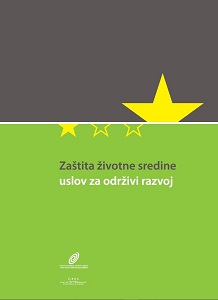
The aim of the project "What brings the European Union - case studies on the effects of Serbia's accession to the European Union in the fields of ecology, agriculture and cross-border cooperation" is to investigate and to indicate to citizens and decision-makers at the national and local level in Serbia whether, in what way, to what extent and under what conditions the processes of europeanization and Serbia's approach to the European Union increase the prospects of Serbia to accelerate its development and make better use of its development potential. Research was carried out in three areas: protection of the human environment, cross-border cooperation and agriculture. Research was done on the examples of specific local communities using the "case study" methodology, which allows one to easily observe the possible effects of europeanization on examples from practice and in a recognizable environment in which the citizens of Serbia live, face certain problems and try to solve them. The aforementioned three areas were selected for research because they are either spoken of as an essential development resource, regardless of the limits for their use (agriculture), or without a sufficient understanding of their function (cross-border cooperation), or without a clear observation of how and under what conditions they have a limiting or stimulating effect on other development potentials (protection of the human environment) and development resources.
More...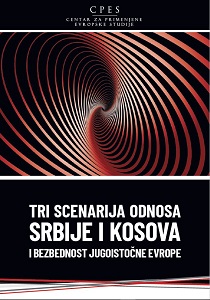
Almost twenty years have passed since the end of the war in Kosovo and more than ten years since Kosovo declared its independence. To this day, not only have the future and stable relations between Serbia and Kosovo not been finally defined during that time, but sometimes one gets the impression that they are still further away from that. And the reason is not in the absence of conversation. The Brussels dialogue, the current format of negotiations on the normalization of relations between the two sides, began in 2011, first as a dialogue on "technical issues", and in 2012 it was continued at the highest level. The outcome of this process was the so-called The first Brussels agreement in April 2013, which opened the way for Serbia to start negotiations on membership in the European Union from January 2014. Since then, the two sides have conducted negotiations and reached agreements on concrete issues - the status of the police force, the judiciary, the education and health systems, energy, etc. with different degrees of application.
More...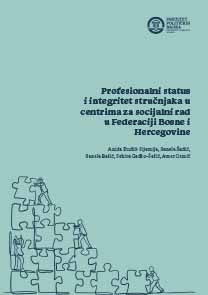
This study analyzes the professional status and working conditions of experts in social work centers in the Federation of Bosnia and Herzegovina, highlighting key challenges they face. The main issues include work overload, lack of resources, security threats, bureaucratic constraints, and limited opportunities for professional development. These factors negatively impact professional autonomy and the quality of social services.The research findings indicate the need for systemic reforms, including increased financial and human resources, improved working conditions, legal framework reforms, and enhanced security measures. Special emphasis is placed on the importance of protecting professionals, developing training programs, and ensuring psychosocial support to reduce emotional exhaustion and stress.Improving working conditions in social work centers can significantly enhance service quality and the professional integrity of experts, contributing to overall social well-being, reducing social inequalities, and strengthening social cohesion.
More...